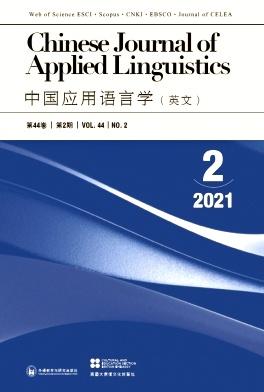运动相容性对二语复杂动作句理解的影响:一个ERP研究
IF 1.1
4区 教育学
Q3 EDUCATION & EDUCATIONAL RESEARCH
引用次数: 0
摘要
体现理论认为语言理解涉及大脑的感觉-运动模拟。本研究考察了汉语作为第二语言学习参与者在理解与动作相关的语言材料时,大脑对运动相容性效应的反应。在这项研究中,参与者被要求阅读与动作相关的句子,这些句子描述了一个代理通过操纵时间连词同时或依次执行两个手动动作。同时动作的句子用汉语平行结构一一一一......一一一一......(“而”)表示不一致的动作条件,顺序动作的句子用一一......一一......(“后”)表示一致的动作条件。用第二个动词短语记录事件相关电位(erp)。同时动作句的前中央后期正性高于顺序动作句,这表明中国第二语言学习者在加工动作相关复杂句时,尽管需要更多的认知资源和较长的加工时间,但仍整合了具身知识。本文章由计算机程序翻译,如有差异,请以英文原文为准。
Motor Compatibility Effect on the Comprehension of Complex Manual Action Sentences in L2: An ERP Study
Abstract Embodiment theories proposed that the comprehension of language involves sensory-motor simulation in the brain. The present study examined the brain response to motor compatibility effect in comprehending action-related linguistic materials for participants learning Chinese as a second language (L2). In this study, participants are required to read action-related sentences describing an agent performing two manual actions simultaneously or sequentially by manipulating temporal conjunctions. The sentences with simultaneous actions are marked by Chinese parallel structure 一边……一边…… (“while”) showing non-congruent motor condition while the sequential action sentences are marked by 先……然后…… (“after”) showing congruent motor condition. Event-Related Potentials (ERPs) were recorded with the second verb phrase. A larger fronto-central late positivity was observed for the sentences with simultaneous actions rather than the sentences with sequential actions due to body constraints, revealing that late L2 Chinese learners integrate embodied knowledge while processing action-related complex sentence despite demanding more cognitive resources, and longer processing time.
求助全文
通过发布文献求助,成功后即可免费获取论文全文。
去求助
来源期刊

Chinese Journal of Applied Linguistics
EDUCATION & EDUCATIONAL RESEARCH-
CiteScore
1.50
自引率
0.00%
发文量
377
期刊介绍:
The Chinese Journal of Applied Linguistics (CJAL) (formerly known as Teaching English in China – CELEA Journal) was created in 1978 as a newsletter by the British Council, Beijing. It is the affiliated journal of the China English Language Education Association (founded in 1981 and now the Chinese affiliate of AILA [International Association of Applied Linguistics]). The Chinese Journal of Applied Linguistics is the only English language teaching (ELT) journal in China that is published in English, serving as a window to Chinese reform on ELT for professionals in China and around the world. The journal is internationally focused, fully refereed, and its articles address a wide variety of topics in Chinese applied linguistics which include – but also reach beyond – the topics of language education and second language acquisition.
 求助内容:
求助内容: 应助结果提醒方式:
应助结果提醒方式:


